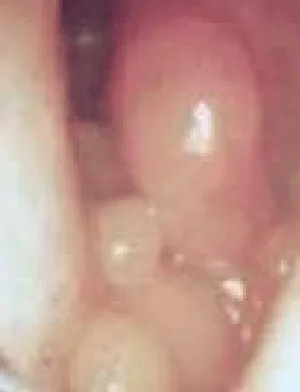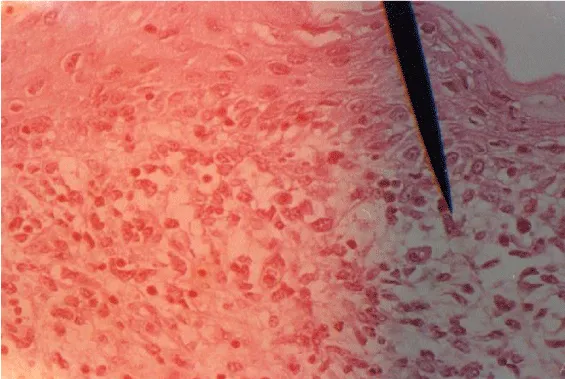Global Journal of Cancer Therapy
Rare Case Botryoid Rhabdomyosarcomas of the Genital Tract. About a case in a 30-month-old child
M Lahfaoui* and H Benhaddou
Cite this as
Lahfaoui M, Benhaddou H (2020) Rare Case Botryoid Rhabdomyosarcomas of the Genital Tract. About a case in a 30-month-old child . Glob J Cancer Ther 6(1): 007-009. DOI: 10.17352/2581-5407.000028Rhabdomyosarcomas are the most common soft tissue sarcomas developed in children under 15 years of age. The reported finding is a vaginal tumour developed in a 30-month-old granddaughter. This was a typical botryoid rhabdomyosarcoma that usually occurs in the hollow organs lined with mucous membrane. Rhabdomyosarcomas have multiple aspects that vary according to the degree of cellular differentiation. The majority of these tumours can be classified into four histological categories: embryonic, botryoid, alveolar or pleomorphic. Treatment involves excisional surgery combined with radiotherapy and chemotherapy. The prognosis remains bleak despite therapeutic advances in recent years.
Introduction
Rhabdomyosarcomas are the most common soft tissue sarcomas developed in children under 15 years of age. These tumours respond to multidisciplinary management: conservative surgery (Figure1), multi-chemotherapy and radiotherapy. Although the prognosis is always dire, a significant proportion of children treated in this way do not metastasize [1]. We present a case of Sarcoma botryoides to illustrate the difficulties encountered by pediatric surgeons in the management of this malignant and aggressive tumor.
Case repport
We report the observation of an 30-month-old girl with multiple whitish-looking polyploid formations, delivered at the vulva. Radiological studies, pelvic computerized tomographic scan (CT) with contrast revealed a solid, cystic mass 5cm3, located anterior to the rectum, and at the posterior-superior aspect of the bladder (Figure 2). There was no extension of the tumor beyond the vagina. Abdominal palpation did not reveal any abnormality, as did the preoperative laboratory workup. Removal of 12 polyps was performed. The polyps were pedicled, implanted on all vaginal walls, about three centimeters from the vulval orifice. Removal was performed vaginoscopically.
Anatomopathological examination of the specimen showed that it was a polypoid (grape-like) tissue bordered by a slightly hyperplastic squamous epithelium. Beneath this epithelium, within a myxoid layer, a proliferation of disseminated tumour cells was observed with an inconspicuous cytoplasm, a hyperchromatic, rounded or elongated nucleus, sometimes presenting cytonuclear atypia with monstrosity and polynucleation. Mitoses were numerous and atypical. In other sections, tumour cell proliferation was found in the subepithelial part of the tumour resulting from an increase in cellularity (cambial layer) (Figure 3). The myxoid stroma was very prominent in places. It was a highly vascularized tumour with endotheliocapillary hyperplasia. This was suggestive of a botryoid rhabdomyosarcoma. An immunohistochemical examination confirmed the diagnosis.
Discussion
The clinical signs of botryoid rhabdomyosarcomas in boys are urinary signs due to bladder or prostate involvement. In the girl, the same signs can be found but, most often, it is the appearance of a “polyp” or cystic formation at the vulva, as was the case in our observation. In other cases, it is vaginal haemorrhages [2]. Scintigraphy studies the renal impact. The cystography shows an upward and forward displacement of the bladder in the extravesical forms and, in the bladder forms, polycyclic gaps. A cystoscopy assesses the lesions and allows biopsies to be taken. An extension assessment is performed locally and at a distance to detect possible metastases [3]. Histologically, rhabdomyosarcomas have multiple aspects which vary according to the degree of cellular differentiation [4]. The majority of these tumours can be classified in four histological categories: embryonic, botryoid, alveolar or pleomorphic:
Embryonal rhabdomyosarcoma is the most common. It accounts for 50-60% of all rhabdomyosarcomas. It mainly affects children under 15 years of age. It is located mainly on the head and neck. It is also found in the genitourinary tract and retroperitoneum. Microscopically, it is a microscopically undifferentiated cell. Immunohistochemical examinations are most often necessary to formally identify the lesion.
Botryoid rhabdomyosarcoma is a variant of the embryonic type. It accounts for 5-10% of all rhabdomyosarcomas. It is characterized by a polypoid appearance in bunches of grapes. There are few cells that are scattered in a large amount of mucoid substance. There may be areas of high tumour development, called “cambium layer” by analogy with the area of maximum growth of a tree. The majority of these tumours are located in hollow organs that are lined with mucous membrane.
Alveolar rhabdomyosarcoma comes second in frequency. It accounts for about 20% of rhabdomyosarcomas and occurs in young people between the ages of 10 and 25.
Pleomorphic rhabdomyosarcoma is a tumour that is sometimes described as the classic type of rhabdomyosarcoma. However, it accounts for only 5% of rhabdomyosarcomas. It occurs in patients of all ages with a peak frequency in patients over 40 years of age. It is primarily a tumour of the large muscles of the extremities and especially of the thigh.
Three therapeutic means can be used, either alone or in sequential combination: surgery, radiotherapy, chemotherapy: surgery may be limited in the case of a poorly developed tumour or extensive and very dilapidated in the case of extensive lesions or those seen late; radiotherapy is used as a complement to surgery and with a curative aim. Irradiation at high doses enables local tumour sterilisation to be obtained, but does not prevent the appearance of distant metastases [5]. Chemotherapy uses molecules that are effective on embryonic rhabdomyosarcomas. They are used in combination and injected cyclically. These products (actinomycin D, adriamycin, cyclophosphamide, vincristine, procarbazine, etc.) sometimes lead to spectacular tumour reductions. The aim of chemotherapy is twofold: to reduce the tumour mass locally and to prevent the development of distant metastases [6]. We must consider other differential diagnosis of sarcoma botryoides includes other malignant tumors, such as germ cell tumors of the vagina and clear cell sarcoma. Nonmalignant entities included in the differential diagnosis include a prolapsed urethra, paraurethral cyst, ureterocele, hydrocolpos, genital warts, and condylomata acuminate [7,8].
Conclusion
Botryoid rhabdomyosarcomas of the urogenital sinus are rare lesions that occur only in young children. Due to their specific location and characteristic appearance, especially in young girls, diagnosis is relatively easy. Unfortunately, the prognosis remains bleak despite therapeutic advances in recent years.
- Enzinger FM, Weiss SW (2013) -Rhabdomyosarcoma. In: Soft Tis - sue Tumors. MOSBY, New York 539-559. Link:
- Flamant F, Schweisguth O (2002) Rhabdomyosarcomes embryonnaires du sinus uro-génital. In: Debre R and Lelong M - Pédiatrie, Flammarion, Paris 1031v-1032
- Parham DM, Alaggio R, Coffin CM (2012) Myogenic Tumors in ChildrenAnd Adolescents. Pediatr Dev Pathol 15: 211–238. Link: https://bit.ly/2Wf3MsG
- Guya JB, Casteillob F, Vallarda A, Espenela S, Forestb F, et al. (2016) Rhabdomyosarcomes d’origine gynécologique: revuegénérale et principes de prise en charge. Link: https://bit.ly/3aMoBkc
- Habibi L (2017) Etude du rhabdomyosarcome, chez l'enfant dans le service d'oncologie et hématologie pédiatrique.These, Faculté de médecine et de pharmacie de Marrakech, Maroc.
- Aboud MJ (2019) Vaginal Parts of Sarcoma Botryoides in Children: A Case Report. Acta Scientific Paediatrics 2: 100-104. Link: https://bit.ly/2KLHpWl
- Raney RB, Anderson JR, Barr FG, Donaldson SS, Pappo AS, et al. (2001) Rhabdomyosarcoma and undifferentiated sarcoma in the first two decades of life: a selective review of inter group rhabdomyosarcoma study group experience and rationale for Intergroup Rhabdomyosarcoma Study V. J Pediatr Hematol Oncol 23: 215-220. Link: https://bit.ly/2WbYD4f
- Sardinha MGP, Ramajo FM, Ponce CC, Marques CF, Bittencourt CMF, et al. (2019) Uterine cavity embryonal rhabdomyosarcoma. Autops Case Rep 9: e2019104. Link: https://bit.ly/2y9OX2q

Article Alerts
Subscribe to our articles alerts and stay tuned.
 This work is licensed under a Creative Commons Attribution 4.0 International License.
This work is licensed under a Creative Commons Attribution 4.0 International License.



 Save to Mendeley
Save to Mendeley
